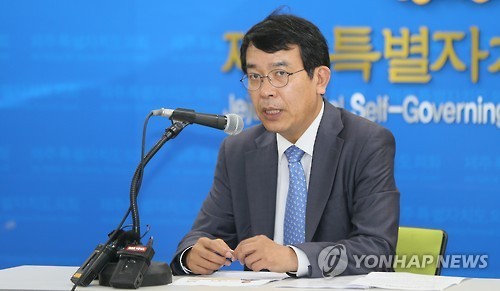Aging army choppers pose safety hazards: lawmaker
By Yoon Min-sikPublished : Sept. 22, 2016 - 16:44
More than half of the helicopters operated by the South Korean Army are over 30 years old, an opposition lawmaker said Thursday, raising concerns about soldiers’ safety.
According to Rep. Kim Jong-dae of the minor opposition Justice Party, 230 of the Army’s 550 helicopters have been in operation for 30 or more years. The standard lifespan of a helicopter for the South Korean Army is 30 years.
According to Rep. Kim Jong-dae of the minor opposition Justice Party, 230 of the Army’s 550 helicopters have been in operation for 30 or more years. The standard lifespan of a helicopter for the South Korean Army is 30 years.

Kim, the floor spokesman for his party, pointed out that the aged aircraft had not undergone upgrades that could expand their lifespan.
“In such a case, deterioration or erosion of helicopter parts raises the possibility of an accident. Soldiers are forced to carry out operations with this liability,” Kim said.
Army data obtained by Kim showed that there have been 9 helicopter-involved accidents in the Army during the past 10 years, killing 14 soldiers.
In February, a UH-1 Iroquois chopper crashed, killing three of its passengers. An Army investigation found that the helicopter’s aging hydraulic system had failed, causing a loss of control of the aircraft.
The helicopter involved in the accident was brought into the country in 1973, with the model itself being developed in the 1950s.
In 2008, another UH-1H helicopter crashed into a mountain and left all seven of its passengers dead. It was later revealed that the helicopter lacked critical devices such as a ground proximity warning system.
All 60 of the Army’s UH-1 helicopters are over 30 years old, with the oldest being used in the field since 1966. Of the Army’s 210 MD 500 helicopters, 160 are over 30 years old.
Although the Army is gradually replacing the UH-1Hs with locally developed KUH-1 Surion helicopters, this process won’t be complete until 2022. The MD 500s are to be used until 2031.
Military officials say lack of budget is preventing them from immediately replacing the aircraft.
“The tendency to allocate most of the budget to offensive weapons has forced the Army to retain equipment that threatens the safety of our soldiers. (The military) must make sure that the cited equipment is either upgraded or removed,” Kim said.
By Yoon Min-sik (minsikyoon@heraldcorp.com)
“In such a case, deterioration or erosion of helicopter parts raises the possibility of an accident. Soldiers are forced to carry out operations with this liability,” Kim said.
Army data obtained by Kim showed that there have been 9 helicopter-involved accidents in the Army during the past 10 years, killing 14 soldiers.
In February, a UH-1 Iroquois chopper crashed, killing three of its passengers. An Army investigation found that the helicopter’s aging hydraulic system had failed, causing a loss of control of the aircraft.
The helicopter involved in the accident was brought into the country in 1973, with the model itself being developed in the 1950s.
In 2008, another UH-1H helicopter crashed into a mountain and left all seven of its passengers dead. It was later revealed that the helicopter lacked critical devices such as a ground proximity warning system.
All 60 of the Army’s UH-1 helicopters are over 30 years old, with the oldest being used in the field since 1966. Of the Army’s 210 MD 500 helicopters, 160 are over 30 years old.
Although the Army is gradually replacing the UH-1Hs with locally developed KUH-1 Surion helicopters, this process won’t be complete until 2022. The MD 500s are to be used until 2031.
Military officials say lack of budget is preventing them from immediately replacing the aircraft.
“The tendency to allocate most of the budget to offensive weapons has forced the Army to retain equipment that threatens the safety of our soldiers. (The military) must make sure that the cited equipment is either upgraded or removed,” Kim said.
By Yoon Min-sik (minsikyoon@heraldcorp.com)








![[KH Explains] Hyundai's full hybrid edge to pay off amid slow transition to pure EVs](http://res.heraldm.com/phpwas/restmb_idxmake.php?idx=644&simg=/content/image/2024/04/18/20240418050645_0.jpg&u=20240419100350)







![[From the Scene] Monks, Buddhists hail return of remains of Buddhas](http://res.heraldm.com/phpwas/restmb_idxmake.php?idx=652&simg=/content/image/2024/04/19/20240419050617_0.jpg&u=20240419175937)

![[KH Explains] Hyundai's full hybrid edge to pay off amid slow transition to pure EVs](http://res.heraldm.com/phpwas/restmb_idxmake.php?idx=652&simg=/content/image/2024/04/18/20240418050645_0.jpg&u=20240419100350)

![[Today’s K-pop] Illit drops debut single remix](http://res.heraldm.com/phpwas/restmb_idxmake.php?idx=642&simg=/content/image/2024/04/19/20240419050612_0.jpg&u=)